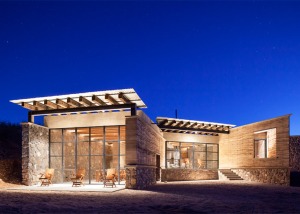 In an age where sustainability and environmental consciousness are at the forefront of architectural innovation, ancient building techniques are experiencing a renaissance. Among these age-old methods, rammed-earth construction stands out as a beacon of eco-friendly building practices. Modern rammed-earth technology combines traditional wisdom with contemporary engineering, offering a sustainable solution to contemporary construction challenges. In this article, we delve into the intricacies of modern rammed-earth technology, examining its process, characteristics, environmental benefits, as well as its advantages and disadvantages.
In an age where sustainability and environmental consciousness are at the forefront of architectural innovation, ancient building techniques are experiencing a renaissance. Among these age-old methods, rammed-earth construction stands out as a beacon of eco-friendly building practices. Modern rammed-earth technology combines traditional wisdom with contemporary engineering, offering a sustainable solution to contemporary construction challenges. In this article, we delve into the intricacies of modern rammed-earth technology, examining its process, characteristics, environmental benefits, as well as its advantages and disadvantages.
The Process of Modern Rammed-Earth Construction
Modern rammed-earth construction involves compressing a mixture of earth, gravel, sand, and stabilizers within a formwork to create solid, durable walls. The process typically begins with the selection and preparation of suitable soil, which is then mixed with additives such as cement, lime, or asphalt emulsion to enhance its strength and durability. The mixture is then placed in layers within a formwork, which is incrementally compacted using pneumatic or hydraulic rammers. As each layer is compacted, it forms a cohesive, load-bearing wall that gradually rises to the desired height. Once the wall is complete, the formwork is removed, revealing the raw beauty of the rammed-earth structure.
Characteristics of Rammed-Earth Buildings
Rammed-earth buildings exhibit a myriad of characteristics that make them both aesthetically pleasing and environmentally sustainable. One of the most striking features of rammed-earth structures is their natural beauty, with walls displaying unique patterns and textures reminiscent of the earth from which they are formed. Additionally, rammed-earth walls offer excellent thermal mass, effectively regulating indoor temperatures and reducing the need for mechanical heating and cooling systems. This inherent thermal efficiency contributes to significant energy savings over the lifespan of the building. Furthermore, rammed-earth buildings have excellent durability and resilience, with structures capable of lasting for centuries when properly maintained.
Environmental Benefits
The environmental benefits of modern rammed-earth construction are manifold, making it a highly sustainable building practice. Firstly, rammed-earth buildings utilize locally sourced materials, reducing the carbon footprint associated with transportation and extraction. Additionally, the production of rammed-earth walls requires minimal energy compared to conventional building materials such as concrete or steel, further lowering its environmental impact. Moreover, rammed-earth construction promotes biodiversity by preserving natural habitats and reducing habitat fragmentation associated with conventional construction practices. Lastly, rammed-earth buildings are highly recyclable and biodegradable, minimizing waste generation and contributing to a circular economy.
Advantages of Modern Rammed-Earth Technology
Modern rammed-earth technology offers numerous advantages over conventional building methods, making it an attractive choice for architects, builders, and homeowners alike. One of the primary advantages is its cost-effectiveness, as rammed-earth construction typically requires lower material and labor costs compared to traditional building techniques. Additionally, rammed-earth buildings have excellent thermal performance, providing occupants with a comfortable indoor environment year-round. Furthermore, rammed-earth structures are highly resistant to fire, pests, and earthquakes, offering enhanced safety and security for occupants. Moreover, rammed-earth construction allows for versatile design options, with walls easily shaped and sculpted to create unique architectural forms.
Disadvantages of Rammed-Earth Construction
Despite its many advantages, modern rammed-earth construction also has some limitations and challenges. One of the main disadvantages is its susceptibility to moisture damage if not adequately protected. Moisture infiltration can weaken the structural integrity of rammed-earth walls and lead to deterioration over time. Additionally, the initial construction process can be labor-intensive and time-consuming, requiring skilled craftsmen and specialized equipment. Moreover, the availability of suitable soil can be a limiting factor in certain regions, necessitating careful site selection and soil testing. Furthermore, while rammed-earth buildings offer excellent thermal mass, they may require supplementary insulation in colder climates to meet energy efficiency standards.
Conclusion
Modern rammed-earth technology represents a harmonious blend of ancient wisdom and contemporary innovation, offering a sustainable solution to the challenges of modern construction. With its natural beauty, excellent thermal performance, and environmental benefits, rammed-earth construction is gaining recognition as a viable alternative to conventional building methods. While it has its limitations and challenges, the advantages of rammed-earth technology far outweigh its disadvantages, making it an attractive option for eco-conscious builders and homeowners. As we continue to prioritize sustainability in the built environment, rammed-earth construction is poised to play a significant role in shaping the future of architecture and construction.
For Further Reading
• At general discussion of the techniques, characteristics, and history of rammed earth construction can be found at Wikipedia: https://en.wikipedia.org/wiki/Rammed_earth
• HowStuffWorks has published a general guide discussing this subject. The article is available at: https://home.howstuffworks.com/rammed-earth-home.htm
• ArchDaily, the architect’s newsletter has published the article “How Rammed Earth Walls are Built” which can be found at https://www.archdaily.com/933353/how-rammed-earth-walls-are-built
